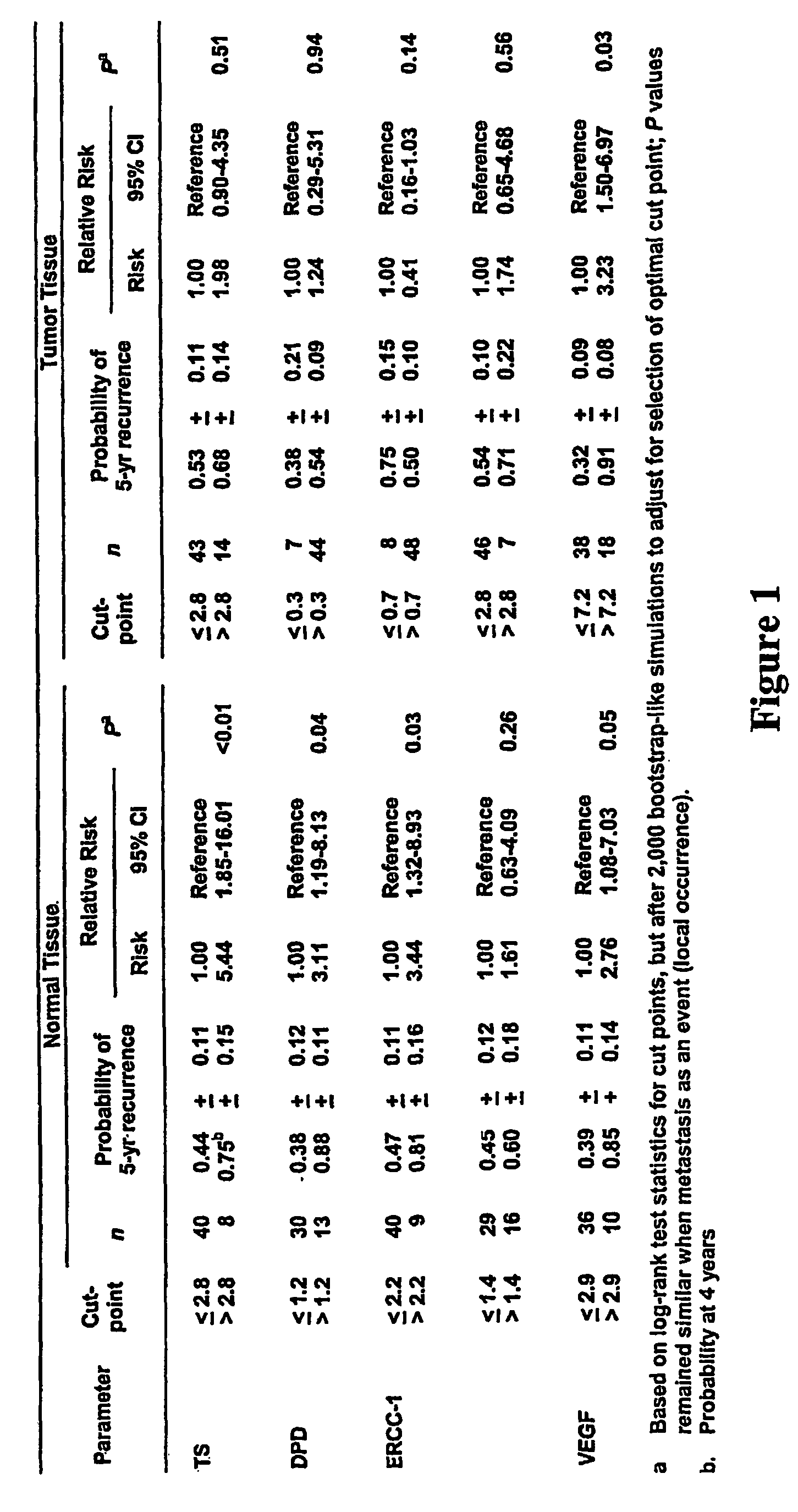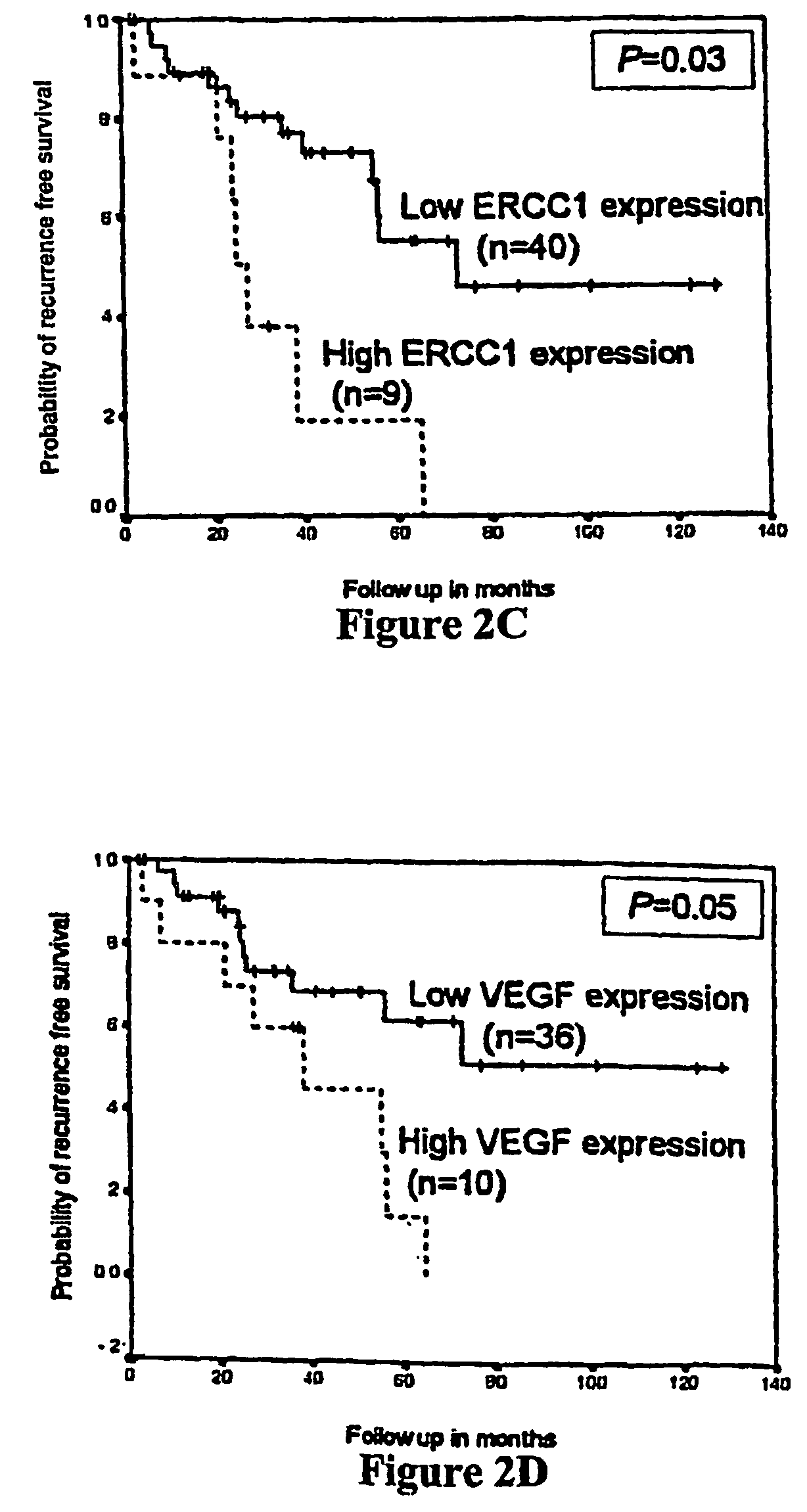Polymorphisms in the ERCC1 gene for predicting treatment outcome
a technology of ercc1 and gene, applied in the field of genetic polymorphisms for diagnosing and treating diseases, can solve problems such as limited cancer chemotherapy
- Summary
- Abstract
- Description
- Claims
- Application Information
AI Technical Summary
Benefits of technology
Problems solved by technology
Method used
Image
Examples
example 1
Gene Expression Profile in Normal Tissue Predicts Pelvic Recurrence in Patients with Rectal Cancer Treated with Adjuvant Chemoradiation Therapy
[0108]The incidence of colorectal cancer has been rising within the last decade and is now as high as 41,000 estimated new cases and 8,500 deaths in the USA per year. (Jemal A. et al. (2002) CA Cancer J Clin 52:23-47). In stage II-IV rectal cancer, local recurrence occurs in 20-70% of patients treated with surgery alone. (Kapiteijn E. et al. (2001) N. Engl. J. Med. 345:638-646). Adjuvant radio-chemotherapy has been generally accepted in the United States as standard therapy for patients who had surgical resection for high-risk rectal cancer. (NIH Consensus Conference. Adjuvant Therapy For Patients With Colon And Rectal Cancer (1990) JAMA 264:1444-1450).
[0109]Previous studies in rectal cancer showed associations between elevated levels of certain genes, including TS and DPD. (Salonga D. et al. (2000) Clin. Cancer Res. 6:1322-1327 and Ishikawa ...
example 2
TS Polymorphism in the Promoter Region Predicts Pelvic Recurrence in Treated Cancer Patients
[0114]The enzyme thymidylate synthase (TS) catalyzes the intracellular conversion of deoxyuridylate to deoxythymidylate which is the sole de novo source of thymidylate, an essential precursor for DNA synthesis. (Heidelberger C. et al. (1957) Nature (179):663-666). It has been shown that the human thymidylate synthase gene (hTS) is polymorphic with either double or triple tandem repeats of a 28 base-pair sequence downstream of the cap-site in the 5′ terminal regulatory region. (Horie N. et al. (1995) Cell Struct. Funct. 20:191-197).
[0115]A polymorphism in the TS gene and its correlation with the efficacy of treatment with 5-FU was previously described in co-owned U.S. patent application Ser. No. 09 / 715,764, (the entire contents of which are incorporated by reference herein.) The predictive polymorphism reported in this disclosure is a tandemly repeated 28 base pair sequence in the thymidilate ...
example 3
TS 3′ Polymorphism For Predicting Response And Survival To 5-FU And Oxaliplatin
[0120]This example shows that a polymorphism associated with the TS gene is associated with clinical response and survival to 5-FU / oxaliplatin chemotherapy in patients with cancer. Example 2, supra, reports that the polymorphism in the TS promoter is associated with TS gene expression in the normal tissue and the tumor tissue. The findings indicate that it is possible to predict TS gene expression in the tumor by measuring the TS polymorphism in peripheral blood cells. Recently a polymorphism has been described in the 3′ end of the gene which have found to be associated with intratumoral gene expression. This TS polymorphism is associated with overall survival in patients treated with oxaliplatin and 5-FU and is an independent predictor of outcome.
[0121]Prediction of response to 5-FU based chemotherapy and prediction of optimal dose of 5-FU will maximize therapeutic benefits and minimize treatment risks. ...
PUM
| Property | Measurement | Unit |
|---|---|---|
| distance | aaaaa | aaaaa |
| distance | aaaaa | aaaaa |
| distance | aaaaa | aaaaa |
Abstract
Description
Claims
Application Information
 Login to View More
Login to View More - R&D
- Intellectual Property
- Life Sciences
- Materials
- Tech Scout
- Unparalleled Data Quality
- Higher Quality Content
- 60% Fewer Hallucinations
Browse by: Latest US Patents, China's latest patents, Technical Efficacy Thesaurus, Application Domain, Technology Topic, Popular Technical Reports.
© 2025 PatSnap. All rights reserved.Legal|Privacy policy|Modern Slavery Act Transparency Statement|Sitemap|About US| Contact US: help@patsnap.com



